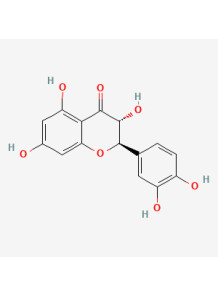Pure-Dihydroquercetin™ (Taxifolin, 98%)
- Product Code: 10418
Flavonoid compounds found in many plants, fruits, and vegetables. It is a dihydro derivative of quercetin, which is a well-known antioxidant and anti-inflammatory agent.
- -
- -
- -
- -
- -
- -
- -
- -
- -
- -
- -
- -
- -
- -
- -
- -
- -
- -
| Test Name | Specification |
|---|---|
| Appearance | Light yellow to off-white powder |
| Assay | =>98.0% |
| Odor | Characteristic |
| Loss on drying | =<5.0% |
| Ash | =<5.0% |
| Pb | =<2.0 ppm |
| Cd | =<1.0 ppm |
| As | =<2.0 ppm |
| Hg | =<1.0 ppm |
| Total Plate Count | <1000 cfu/g |
| Yeast and Mold | <100 cfu/g |
| E. coli | Absent |
| Salmonella | Absent |
| S.aureus | Absent |
Dihydroquercetin (taxifolin) is a flavonoid compound found in many plants, fruits, and vegetables. It is a dihydro derivative of quercetin, which is a well-known antioxidant and anti-inflammatory agent.
There are limited studies on the benefits of dihydroquercetin. However, some studies suggest that it may be beneficial when used topically, such as:
Anti-inflammatory: Dihydroquercetin It has been found to have anti-inflammatory properties which may be useful for treating skin conditions such as eczema, psoriasis and dermatitis.
Antioxidant: Dihydroquercetin It has antioxidant properties that may help protect the skin from damage caused by free radicals.
Sun protection: Dihydroquercetin May help protect from sunlight when used topically. By reducing the amount of UV rays that penetrate the skin.
Wound healing: Some studies suggest that dihydroquercetin may promote wound healing by increasing new blood vessel formation and new skin cell growth.
Usage: Can be used in all types of skin care products.
How to mix: Mix in the formula in the last step. After getting the cream or gel texture By blending it to distribute in the formula. And avoid heat. The formula must contain ethanol or surfactant to help dissolve.
Usage rate: 0.1%
Product appearance: light colored powder
Solubility: Soluble in ethanol or surfactant such as Ultra Solve.
Storage: For long-term storage Store in the refrigerator. Avoid exposure to light or heat. Seal the lid tightly. Shelf life is at least 2 years.
INCI Name : Dihydroquercetin
Be the first to review this product :-)
Recommend Lab-Service
| Lab Service | Price |
|---|
Flavonoid compounds found in many plants, fruits, and vegetables. It is a dihydro derivative of quercetin, which is a well-known antioxidant and anti-inflammatory agent.
Dihydroquercetin (taxifolin) is a flavonoid compound found in many plants, fruits, and vegetables. It is a dihydro derivative of quercetin, which is a well-known antioxidant and anti-inflammatory agent.
There are limited studies on the benefits of dihydroquercetin. However, some studies suggest that it may be beneficial when used topically, such as:
Anti-inflammatory: Dihydroquercetin It has been found to have anti-inflammatory properties which may be useful for treating skin conditions such as eczema, psoriasis and dermatitis.
Antioxidant: Dihydroquercetin It has antioxidant properties that may help protect the skin from damage caused by free radicals.
Sun protection: Dihydroquercetin May help protect from sunlight when used topically. By reducing the amount of UV rays that penetrate the skin.
Wound healing: Some studies suggest that dihydroquercetin may promote wound healing by increasing new blood vessel formation and new skin cell growth.
Usage: Can be used in all types of skin care products.
How to mix: Mix in the formula in the last step. After getting the cream or gel texture By blending it to distribute in the formula. And avoid heat. The formula must contain ethanol or surfactant to help dissolve.
Usage rate: 0.1%
Product appearance: light colored powder
Solubility: Soluble in ethanol or surfactant such as Ultra Solve.
Storage: For long-term storage Store in the refrigerator. Avoid exposure to light or heat. Seal the lid tightly. Shelf life is at least 2 years.
INCI Name : Dihydroquercetin
| Mechanism | - |
| Appearance | - |
| Longevity | - |
| Strength | - |
| Storage | - |
| Shelf Life | - |
| Allergen(s) | - |
| Dosage (Range) | - |
| Recommended Dosage | - |
| Dosage (Per Day) | - |
| Recommended Dosage (Per Day) | - |
| Mix Method | - |
| Heat Resistance | - |
| Stable in pH range | - |
| Solubility | - |
| Product Types | - |
| INCI | - |
Cart
No products



